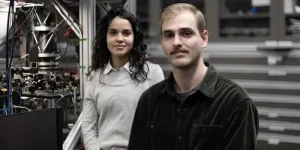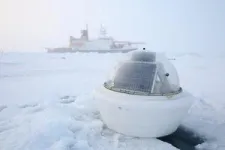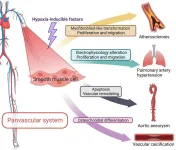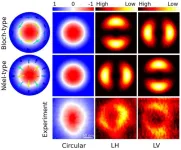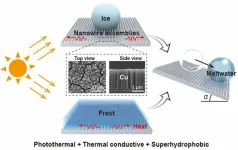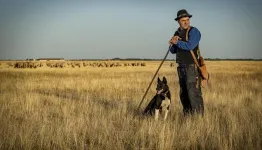(Press-News.org) Scientists at the University of Sydney have, for the first time, used a quantum computer to engineer and directly observe a process critical in chemical reactions by slowing it down by a factor of 100 billion times.
Joint lead researcher and PhD student, Vanessa Olaya Agudelo, said: “It is by understanding these basic processes inside and between molecules that we can open up a new world of possibilities in materials science, drug design, or solar energy harvesting.
“It could also help improve other processes that rely on molecules interacting with light, such as how smog is created or how the ozone layer is damaged.”
Specifically, the research team witnessed the interference pattern of a single atom caused by a common geometric structure in chemistry called a ‘conical intersection’.
Conical intersections are known throughout chemistry and are vital to rapid photo-chemical processes such as light harvesting in human vision or photosynthesis.
Chemists have tried to directly observe such geometric processes in chemical dynamics since the 1950s, but it is not feasible to observe them directly given the extremely rapid timescales involved.
To get around this problem, quantum researchers in the School of Physics and the School of Chemistry created an experiment using a trapped-ion quantum computer in a completely new way. This allowed them to design and map this very complicated problem onto a relatively small quantum device – and then slow the process down by a factor of 100 billion.
Their research findings are published today in Nature Chemistry.
“In nature, the whole process is over within femtoseconds,” said Ms Olaya Agudelo from the School of Chemistry. “That’s a billionth of a millionth – or one quadrillionth – of a second.”
“Using our quantum computer, we built a system that allowed us to slow down the chemical dynamics from femtoseconds to milliseconds. This allowed us to make meaningful observations and measurements.
“This has never been done before.”
Joint lead author Dr Christophe Valahu from the School of Physics said: “Until now, we have been unable to directly observe the dynamics of ‘geometric phase’; it happens too fast to probe experimentally.
“Using quantum technologies, we have addressed this problem.”
Dr Valahu said it is akin to simulating the air patterns around a plane wing in a wind tunnel.
“Our experiment wasn’t a digital approximation of the process – this was a direct analogue observation of the quantum dynamics unfolding at a speed we could observe,” he said.
In photo-chemical reactions such as photosynthesis, by which plants get their energy from the Sun, molecules transfer energy at lightning speed, forming areas of exchange known as conical intersections.
This study slowed down the dynamics in the quantum computer and revealed the tell-tale hallmarks predicted – but never before seen – associated with conical intersections in photochemistry.
Co-author and research team leader, Associate Professor Ivan Kassal from the School of Chemistry and the University of Sydney Nano Institute, said: “This exciting result will help us better understand ultrafast dynamics – how molecules change at the fastest timescales.
“It is tremendous that at the University of Sydney we have access to the country’s best programmable quantum computer to conduct these experiments.”
The quantum computer used to conduct the experiment is in the Quantum Control Laboratory of Professor Michael Biercuk, the founder of quantum startup, Q-CTRL. The experimental effort was led by Dr Ting Rei Tan.
Dr Tan, a co-author of the study, said: “This is a fantastic collaboration between chemistry theorists and experimental quantum physicists. We are using a new approach in physics to tackle a long-standing problem in chemistry.”
Nature Chemistry ‘Direct observation of geometric-phase interference in dynamics around a conical intersection’
DOI: 10.1038/s41557-023-01300-3
DOWNLOAD photos and a gif animation at this link.
DOWNLOAD explainer video on YouTube at this link. (embargoed)
INTERVIEWS
Vanessa Olaya Aguedelo Dr Christophe Valahu Professor Ivan Kassal
PhD student Postdoctoral researcher Research team leader
School of Chemistry School of Physics School of Chemistry
MEDIA ENQUIRIES
Marcus Strom | Science Media Adviser | marcus.strom@sydney.edu.au | +61 423 982 485
DECLARATION
The research was supported by grants from the US Office of Naval Research; the US Army Research Office Laboratory for Physical Sciences; the US Intelligence Advanced Research Projects Activity; Lockheed Martin; the Australian Defence Science and Technology Group, Sydney Quantum; a University of Sydney-University of California San Diego Partnership Collaboration Award; H. and A. Harley; and by computational resources from the Australian Government’s National Computational Infrastructure.
END
Scientists use quantum device to slow down simulated chemical reaction 100 billion times
What happens in femtoseconds in nature can now be observed in milliseconds in the lab
2023-08-28
ELSE PRESS RELEASES FROM THIS DATE:
Assessment of hospital-onset SARS-CoV-2 infection rates and testing practices
2023-08-28
About The Study: In this study of hospitals reporting SARS-CoV-2 infections, there was an increase of hospital-onset SARS-CoV-2 infections when community-onset infections were higher, indicating a need for ongoing and enhanced surveillance and prevention efforts to reduce in-hospital transmission of SARS-CoV-2 infections, particularly when community-incidence of SARS-CoV-2 infections is high.
Authors: Kelly M. Hatfield, M.S.P.H., of the Centers for Disease Control and Prevention in Atlanta, is the ...
Trends in suicide rates among post-9/11 veterans with and without traumatic brain injury
2023-08-28
About The Study: In a large cohort of U.S. military veterans serving after 9/11, suicide rates increased more than 10-fold from 2006-2020, a significantly greater rate of change than in the U.S. adult population. Over the 15-year period, veterans with traumatic brain injury (TBI) had suicide rates 56% higher than veterans without TBI and three times higher than the U.S. adult population.
Authors: Jeffrey T. Howard, Ph.D., of the University of Texas at San Antonio, is the corresponding author.
To access the embargoed study: Visit our For The Media website at this link https://media.jamanetwork.com/
(doi:10.1001/jamaneurol.2023.2893)
Editor’s ...
Estimated lifetime gained with cancer screening tests
2023-08-28
About The Study: The findings of this systematic review and meta-analysis of 18 long-term randomized clinical trials involving 2.1 million individuals suggest that current evidence does not substantiate the claim that common cancer screening tests save lives by extending lifetime, except possibly for colorectal cancer screening with sigmoidoscopy.
Authors: Michael Bretthauer, M.D., Ph.D., of the University of Oslo in Oslo, Norway, is the corresponding author.
To access the embargoed study: Visit our For The Media website at this link https://media.jamanetwork.com/
(doi:10.1001/jamainternmed.2023.3798)
Editor’s ...
Neuropathologic and clinical findings in young contact sport athletes exposed to repetitive head impacts
2023-08-28
About The Study: This case series found that young brain donors exposed to repetitive head impacts were highly symptomatic regardless of chronic traumatic encephalopathy (CTE) status, and the causes of symptoms in this sample are likely multifactorial. Future studies that include young brain donors unexposed to repetitive head impacts are needed to clarify the association among exposure, white matter and microvascular pathologic findings, CTE, and clinical symptoms.
Authors: Ann C. McKee, M.D., of the U.S. Department of Veteran Affairs in Boston, is the corresponding author.
To access the embargoed study: Visit our For The Media website ...
Due to sea-ice retreat, zooplankton could remain in the deep longer
2023-08-28
Due to intensifying sea-ice melting in the Arctic, sunlight is now penetrating deeper and deeper into the ocean. Since marine zooplankton respond to the available light, this is also changing their behaviour – especially how the tiny organisms rise and fall within the water column. As an international team of researchers led by the Alfred Wegener Institute has now shown, in the future this could lead to more frequent food shortages for the zooplankton, and to negative effects for larger species including seals and whales. The study ...
Hypoxia and panvascular diseases: exploring the role of hypoxia-inducible factors in vascular smooth muscle cells under panvascular pathologies
2023-08-28
This study is led by Prof. Junbo Ge (Department of Cardiology, Zhongshan Hospital, Fudan University, Shanghai Institute of Cardiovascular Diseases), Prof. Hua Li (Department of Cardiology, Zhongshan Hospital, Fudan University, Shanghai Institute of Cardiovascular Diseases), and Prof. Hao Lu (Department of Cardiology, Zhongshan Hospital, Fudan University, Shanghai Institute of Cardiovascular Diseases).
As an emerging concept, panvascular diseases encompass a group of cardiovascular disorders characterized mainly by atherosclerosis, involving crucial organs such as the ...
Spintronics: X-ray microscopy unravels the nature of domain walls
2023-08-28
Magnetic skyrmions are tiny vortices-like of magnetic spin textures that - in principle - can be used for spintronic devices, for example very fast and energy-efficient data storage devices. But at the moment it is still difficult to control and manipulate skyrmions at room temperature. A new study at BESSY II analyses the formation of skyrmions in ferrimagnetic thin films of dysprosium and cobalt in real time and with high spatial resolution. This is an important step towards characterising suitable materials with skyrmions more precisely in the future.
Isolated magnetic skyrmions are topologically protected spin textures that are in the focus of research ...
World first drug to target form of previously untreatable life-threatening ‘bad cholesterol’
2023-08-28
A new drug offers a breakthrough world first treatment for Lipoprotein(a), a largely genetic form of cholesterol that increases the risk of heart attack and stroke, announced today by study lead Professor Stephen Nicholls, Director of the Monash University’s Victorian Heart Institute and Victorian Heart Hospital.
High levels of Lipoprotein(a), known as Lp(a) or spoken as ‘LP little a’, impact one in five people globally with no approved treatment currently on the market.
The trial demonstrated the success of Muvalaplin - the first oral drug ever ...
An all-in-one surface design of copper nanowire assemblies to achieve ~100% defrosting efficiency
2023-08-28
Scientists at Dalian University of Technology propose a design of copper nanowire assemblies that can sufficiently enhance the de-icing and defrosting efficiency without conventional energy input. Specifically, the defrosting efficacy approaches 100%, a record-high value compared to reported studies.
The research, published in International Journal of Extreme Manufacturing, shows a simple electrochemical method for fabricating nanowire assemblies with controlled pattern, hierarchy, and size. This enables the simultaneous presentation of photothermal, thermal conductive, and superhydrophobic ...
Social justice for traditional knowledge holders will help conserve Europe’s nature
2023-08-28
It is well known that biodiversity of cultural landscapes is threatened by land abandonment and agricultural intensification. Traditional, low chemical and machinery input management systems have long been acknowledged for their diverse benefits to maintain and enhance biodiversity, however, the recognition of traditional knowledge, on which these traditional management practices are based, started only relatively recently. The recognition of traditional knowledge holders themselves is an even more recent phenomenon. A recently published paper aims to ...
LAST 30 PRESS RELEASES:
Making lighter work of calculating fluid and heat flow
Normalizing blood sugar can halve heart attack risk
Lowering blood sugar cuts heart attack risk in people with prediabetes
Study links genetic variants to risk of blinding eye disease in premature infants
Non-opioid ‘pain sponge’ therapy halts cartilage degeneration and relieves chronic pain
AI can pick up cultural values by mimicking how kids learn
China’s ecological redlines offer fast track to 30 x 30 global conservation goal
Invisible indoor threats: emerging household contaminants and their growing risks to human health
Adding antibody treatment to chemo boosts outcomes for children with rare cancer
Germline pathogenic variants among women without a history of breast cancer
Tanning beds triple melanoma risk, potentially causing broad DNA damage
Unique bond identified as key to viral infection speed
Indoor tanning makes youthful skin much older on a genetic level
Mouse model sheds new light on the causes and potential solutions to human GI problems linked to muscular dystrophy
The Journal of Nuclear Medicine ahead-of-print tip sheet: December 12, 2025
Smarter tools for peering into the microscopic world
Applications open for funding to conduct research in the Kinsey Institute archives
Global measure underestimates the severity of food insecurity
Child survivors of critical illness are missing out on timely follow up care
Risk-based vs annual breast cancer screening / the WISDOM randomized clinical trial
University of Toronto launches Electric Vehicle Innovation Ontario to accelerate advanced EV technologies and build Canada’s innovation advantage
Early relapse predicts poor outcomes in aggressive blood cancer
American College of Lifestyle Medicine applauds two CMS models aligned with lifestyle medicine practice and reimbursement
Clinical trial finds cannabis use not a barrier to quitting nicotine vaping
Supplemental nutrition assistance program policies and food insecurity
Switching immune cells to “night mode” could limit damage after a heart attack, study suggests
URI-based Global RIghts Project report spotlights continued troubling trends in worldwide inhumane treatment
Neutrophils are less aggressive at night, explaining why nighttime heart attacks cause less damage than daytime events
Menopausal hormone therapy may not pose breast cancer risk for women with BRCA mutations
Mobile health tool may improve quality of life for adolescent and young adult breast cancer survivors
[Press-News.org] Scientists use quantum device to slow down simulated chemical reaction 100 billion timesWhat happens in femtoseconds in nature can now be observed in milliseconds in the lab
